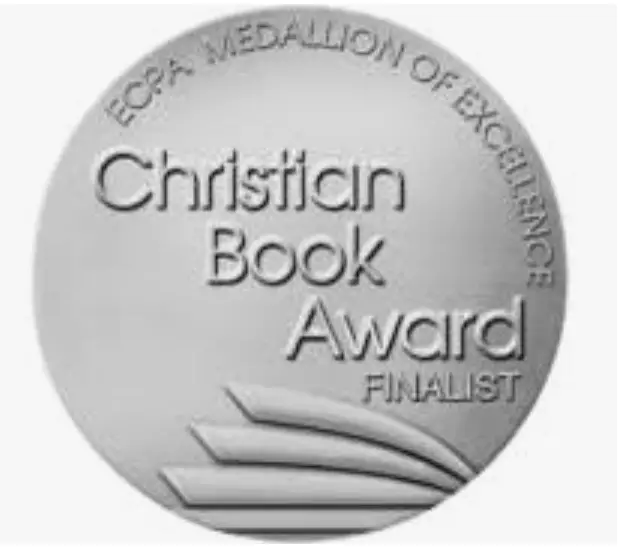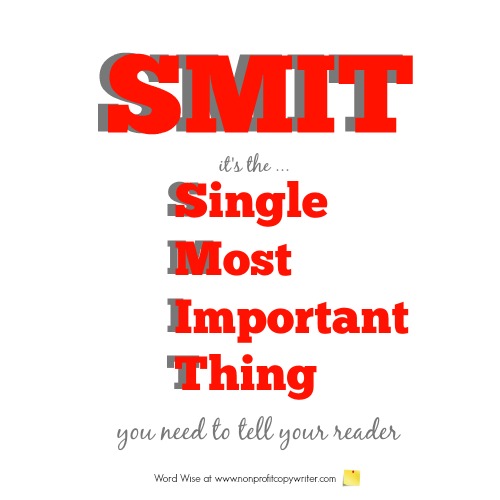Save Time: Get 5 Simple Writing Tips
you can put to use in 10 minutes
How to Find the Main Idea of Your Content Before You Write
Award-winning writer Kathy Widenhouse has helped hundreds of nonprofits and writers produce successful content , with 750K+ views for her writing tutorials. She is the author of 9 books. See more of Kathy’s content here.
Updated 12.10.24
The writing process is easier when you find the main idea – the single most important thing (SMIT) to tell your readers – before you write.
If you do, you’ll save yourself time and aggravation. And your writing will have clarity.
When I first started writing seriously, I struggled with this piece of advice. My problem was that in many instances, I didn’t know the main point I wanted to communicate in an article or blog post or letter. I had captured plenty of ideas but didn’t know how to process them to choose one.
Since then, I’ve come across a tool that has helped accelerate the process quite a bit. I wished I’d known about it when I first started writing.
SMIT: a principle to follow
SMIT is a simple acronym credited to Australian fundraising consultant Jonathon Grapsas, who routinely asks himself and his clients to identify the Single Most Important Thing he needs to tell his reader.
You can use the SMIT principle for any writing project. As you prepare to write, simply ask yourself, “What is the Single Most Important Thing I need to tell my reader in this piece?” When you articulate your project’s SMIT, you can stay on target.
Processing
ideas helps you find your main idea
Maybe you can identify right out the gate what the Single Most Important Thing your content will communicate.
But if not, simply start with your pool of ideas. Sort through then and determine which ones to discard, which ones to hold to pursue at another time, and which ones to process right away so you can find the single most important one.
As I wrote this piece, I had all kinds of thoughts about processing ideas. I was tempted to jump in to explain them all. But SMIT kept needling the back of my brain. I asked myself, “what is the Single Most Important Thing I want to tell my readers about sorting ideas?” And I went through a simple little process that I’ve adopted during my content writing journey.
How to find the main idea for any piece of content
You can follow the same process as you write any kind of content, no matter how large or small the project. To do so, make three lists. (This worksheet can guide you through processing your ideas and choosing one main idea. It’s fillable and reusable.)
Let’s look at this post as an example. Remember, I got excited about helping readers processing their ideas to write a piece of content. But “processing ideas” is a broad topic – and an intangible one. To find the main idea that would work for a blog post or article, I started with three lists.
List #1: Audience
Who are you writing to? List possible readers. You can narrow your focus later, but for now, record your potential target audiences.
My list included writers … beginning writers … frustrated writers.
List #2: Problem
What topic do your readers want to know about? What problem do they face or what change do they need in their lives?
Writers face lots of challenges when putting together any piece:
- Choosing a topic
- Getting ideas
- Processing ideas
- Conducting research
- Narrowing a topic to a main idea
- Choosing points to support the main idea
- Writing a helpful conclusion
- Writing a headline
- Finding a place to publish
- … and so forth.
List #3: Outcome
What do you want readers to learn from your piece of content? How do you want them to be different … acquire a skill … change their attitude … increase awareness … use a tip?
My list of desired outcomes for this post looked something like this:
- I want my readers to know how to write clearly. (Too vague, too broad)
- I want my readers to understand the importance of targeting their audience. (A topic all its own)
- I want my readers to see how one main idea focuses their writing. (A valuable principle to understand but hard to carry out)
- I want my readers to know how to choose one main idea for a piece of content (very practical)
- I want my readers to have a simple tool to use to help them choose one main idea for a piece of content (practical and specific)
Use this simple main idea generator to narrow your point
Once you have your lists, sort through them. Choose one item from each of the three. Whittle down your audience … the problem you’d like to help them fix … and the outcome you’d like them to experience. Use this tool:
[Audience] + [Problem] + [Outcome] = Main Idea
I ended up with this:
- Audience: writers
- Problem: processing ideas
- Outcome: use a simple tool to choose a main point
My SMIT is this:“Writers can process their ideas and choose a main point by using a simple tool.”
Your Main Idea Generator:
Find the single most important point in your content with this reusable step-by-step worksheet.
Is SMIT Really a Word?
Yep. “Smit” is past tense for “smite,” a verb that means to defeat, conquer, strike, or hit.
But I digress. And I don’t want to get away from my main point.
Finding the Single Most Important Thing to tell your reader means you’re able to hit your point clearly. Do that and you’ll begin to conquer vague messaging.
Gather your ideas for Audience, Problem, and Outcome. Sort them. Then write down your SMIT. There’s a good chance you’ll need to tweak and massage it or perhaps rewrite it altogether, but in the end you’ll have clarity.
The SMIT principle applies to processing ideas for any project: to writing a book, an article, a blog post, a devotional, an appeal letter …
It’s a time-saving tool that makes you a better writer. You’ll get faster at using it. In fact, much of the time, I process my ideas and narrow my point in my head. The more you do the SMIT, the easier it will be. And your readers will thank you because you get to the point.
More Tips about the Writing Process
My Sanity-Saving Research Tip for Writers ...
Use this Personal Main Idea Generator to Find Your Content Point ...
How to Narrow Your Article Main Idea ...
Use "The Power of One Principle" to Write More Memorable Content ...
How to Develop a Story Idea ,,,
7 Brainstorming Techniques for Writers ...
The Writing Process: Key to Writing Faster and Better ...
How To Write Faster: Use Bursts AND Binges ...
Avoid Panic: A Practical Way to Estimate Writing Time for a Project ...
Secret of Success: Know How to Set and Achieve a Writing Goal ...
3 Tips for Starting Your Writing Project ...
How to Test an Article Idea ...
Capturing ideas for writing projects: a system is the solution ...
How to Write a Thesis Statement ...
4 Writing Styles: When to Use Each One ...
How to Write an Introduction (or Lead, Lede, Hook) ...
Tips for Writing a Hook for Your Article or Blog Post ...
Pre-Writing: 4 Easy Steps to Make Your Writing Go Faster ...
Tips about the Writing Process on our Pinterest board ...
Return from Know the Main Idea to Nonprofit Copywriter home
This is an updated article. I review and refresh my content periodically to give you the most relevant and useful information.
As an Amazon Associate I earn from qualifying purchases.
Share This Page

Named to 2022 Writer's Digest list
BEST GENRE/NICHE WRITING WEBSITE


Stop Wasting Time!
Grab your exclusive FREE guide, "5 Simple Writing Tips You Can Put to Use in 10 Minutes or Less"













